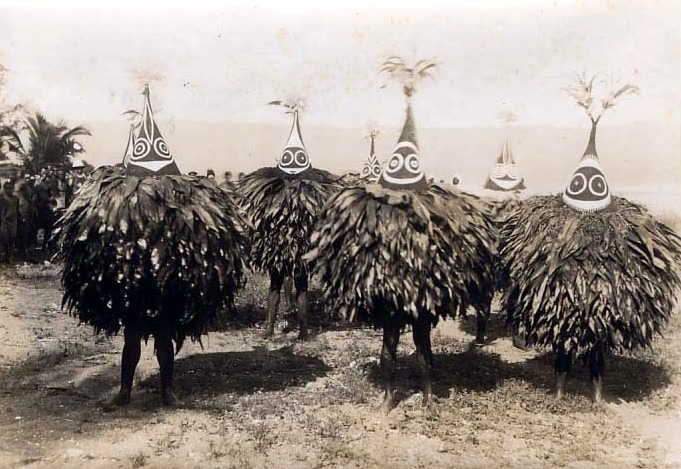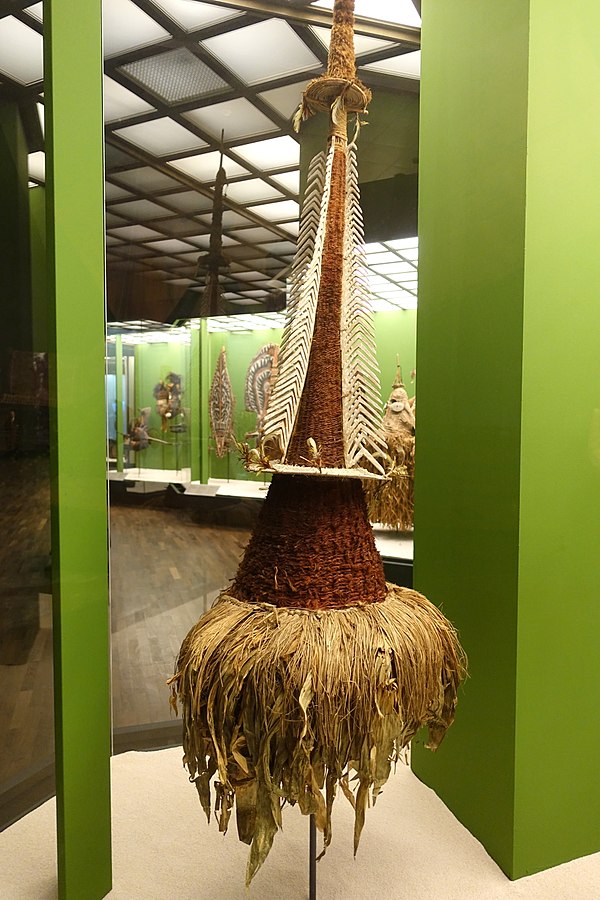The Duk-Duk Costume occupies a central role in the cultural landscape of Papua New Guinea. More than just an item of clothing, it is a key component of the sacred ceremonies conducted by the local communities. Its distinctive appearance and the secretive nature of its usage intrigue many who are keen to learn about the diverse cultural practices of the Pacific Islands.
The mystery surrounding the Duk-Duk Costume is integral to the social and ritual life of certain Papua New Guinean tribes. It acts as a link connecting the past with the present, bearing the essence of the ancestors’ knowledge and the narratives of those who have worn it over the years. This article aims to provide an overview of the Duk-Duk Costume’s role in ceremonial events and its importance in the wider spectrum of Papua New Guinea’s cultural identity.
Historical Background
The Duk-Duk Costume traces its roots back to the Tolai people of East New Britain Province in Papua New Guinea. Historically, the costume and the associated Duk-Duk society played a multifaceted role within the community, serving as a tool for social control, religious expression, and the administration of justice. The origins of the Duk-Duk Costume are steeped in the oral traditions and myths of the Tolai people, making it an integral part of their cultural heritage.
Evolution and Role in Society
Over the years, the Duk-Duk Costume has evolved, both in design and function, while retaining its core significance. Initially, it may have been used primarily in religious and ceremonial contexts, but over time, its role expanded to include the enforcement of social norms and laws. The costume’s presence would signify the enactment of rituals that reinforced community values and resolved conflicts. This evolution reflects the adaptability of the Tolai people’s traditions to changing social landscapes, ensuring the costume’s continued relevance in their society.
The Duk-Duk Costume’s enduring presence in Papua New Guinean culture highlights the deep historical roots and the dynamic nature of indigenous practices. Through its transformations, the costume has remained a symbol of authority and tradition, bridging the past with the present and guiding the community through the challenges of modernity.
The Duk-Duk Costume Explained
The Duk-Duk Costume is not only a visually striking piece of attire but also a vessel of profound cultural and symbolic meanings. Worn during specific rituals and ceremonies, this costume is deeply intertwined with the traditions and spiritual beliefs of the Tolai people. Its construction and design are a testament to the ingenuity and deep-rooted cultural practices of Papua New Guinea.
Design and Materials
- Mask: The most distinctive feature is the elaborate mask, usually made from bark cloth or woven fibers, painted in vibrant colors to represent different deities or spirits.
- Body Covering: The wearer’s body is often covered in leaves, fibers, or cloth, creating a non-human appearance that adds to the costume’s mystique.
- Accessories: Decorative elements such as feathers, shells, and traditional ornaments may adorn the costume, each adding layers of meaning and symbolism.
Symbolic Meanings
- Anonymity and Transformation: The costume completely conceals the wearer’s identity, allowing them to embody the spirit or deity represented by the costume. This transformation is central to the ritual’s effectiveness and the community’s engagement with the supernatural.
- Authority and Order: The Duk-Duk Costume symbolizes social order and authority. Its appearance in rituals often signifies the enforcement of societal norms and laws.
- Connection to Nature: The use of natural materials and motifs in the costume’s design reflects the Tolai people’s deep connection to their environment, emphasizing the interdependence between humans and nature.
The Duk-Duk Costume serves as a bridge between the physical and spiritual worlds, embodying the cultural heritage and collective identity of the Tolai community. Its intricate design and symbolic depth make it a fascinating subject of study, offering insights into the rich tapestry of Papua New Guinean cultural traditions.
The Role of the Duk-Duk Costume in Rituals
The Duk-Duk Costume is integral to the performance of various rituals and ceremonies within the communities of Papua New Guinea, particularly among the Tolai people. These events, rich in tradition and symbolism, underscore the costume’s significance in reinforcing social norms, imparting spiritual teachings, and facilitating communal bonding.
Ceremonial Functions
- Enforcement of Law and Order: The Duk-Duk society, whose members wear these costumes, often plays a role in maintaining social order. The appearance of individuals in Duk-Duk attire can signify the execution of justice, where they act as mediators or enforcers of community rules.
- Spiritual and Religious Rites: The costume is central to rituals that connect the community with the spiritual realm. Wearers, embodying ancestral spirits or deities, perform dances and rites that are believed to invoke blessings, ensure fertility, or appease the spirits.
Impact on Participants and Observers
The elaborate and otherworldly appearance of the Duk-Duk Costume instills a sense of awe and reverence among participants and onlookers, reinforcing the solemnity of the rituals. These events serve as communal gatherings, strengthening social bonds and reinforcing a collective identity. The rituals involving the Duk-Duk Costume are pivotal moments of socialization, education, and reaffirmation of cultural values.
Symbolic Representation
The rituals associated with the Duk-Duk Costume are rich in symbolic actions and narratives that convey moral lessons, historical events, and societal expectations to the participants, particularly the younger generation. The use of the costume in these ceremonies is a manifestation of respect and longing for ancestral guidance and wisdom, ensuring that the link between the past and present remains unbroken.
The role of the Duk-Duk Costume in rituals is multifaceted, encompassing the enforcement of social norms, the facilitation of spiritual connections, and the strengthening of community ties. Through these ceremonial uses, the costume continues to be a living, vibrant part of the cultural fabric of Papua New Guinea, embodying the enduring spirit and values of its people.
The Secretive Nature of the Duk-Duk Society
The Duk-Duk Society, closely associated with the iconic Duk-Duk Costume, is shrouded in secrecy and exclusivity, adding an intriguing layer to the cultural landscape of Papua New Guinea. This secret society plays a crucial role in the ceremonial use of the Duk-Duk Costume and in the broader social and spiritual life of the communities it serves.
Membership and Secrecy
- Selective Membership: Membership in the Duk-Duk Society is typically reserved for male elders of the community, selected through a rigorous and secretive process. The criteria for selection are closely guarded, emphasizing the society’s exclusive nature.
- Veil of Secrecy: The activities, rituals, and knowledge associated with the Duk-Duk Society are kept secret from non-members, including the intricate details of the Duk-Duk Costume’s construction and the meanings of its symbols. This secrecy serves to enhance the mystical aura surrounding the society and its rituals.
Roles and Responsibilities
Members of the Duk-Duk Society are seen as guardians of tradition, responsible for preserving the rituals, dances, and oral histories associated with the Duk-Duk Costume. Beyond their ceremonial duties, members often play a role in enforcing social norms and laws within the community, using the authority vested in them by their mystical association with the Duk-Duk Costume.
The Mystique of the Duk-Duk Costume
- Symbol of Power and Mystery: The secretive nature of the Duk-Duk Society contributes to the mystique of the Duk-Duk Costume, making it a powerful symbol of authority and tradition. The costume’s appearance in public ceremonies is a rare and revered event, marked by a deep communal respect for the traditions it represents.
- Spiritual Intermediaries: Wearers of the Duk-Duk Costume, as representatives of the Duk-Duk Society, are viewed as intermediaries between the spiritual and physical worlds. Their actions during rituals are believed to have profound implications for the community’s well-being, further elevating the costume’s significance.
The secretive nature of the Duk-Duk Society is a key aspect of its allure and authority, reinforcing the ceremonial importance of the Duk-Duk Costume and maintaining its status as a revered symbol of cultural heritage and spiritual power in Papua New Guinea.
Challenges and Preservation
The Duk-Duk Costume, a symbol of cultural heritage and identity in Papua New Guinea, faces several challenges in the modern era. These challenges stem from both internal and external pressures, threatening the continuity of this traditional practice. However, efforts are underway to preserve the costumes and the rituals associated with them, ensuring they remain a vibrant part of Papua New Guinea’s cultural landscape.
Challenges
- Modernization and Globalization: The rapid pace of modernization and the influence of globalization pose significant threats to traditional practices. As younger generations are drawn towards urban centers and global cultures, there’s a risk of diminishing interest and participation in traditional rituals.
- Loss of Knowledge: The secretive nature of the Duk-Duk Society means that knowledge about the Duk-Duk Costume and its associated rituals is closely held. With the passing of older members, there’s a risk that crucial aspects of this tradition could be lost if not adequately documented and shared with younger generations.
- Environmental Concerns: The materials used in the construction of the Duk-Duk Costume, often sourced from the local environment, may become harder to obtain due to environmental degradation and climate change.
Preservation Efforts
- Cultural Documentation: Efforts are being made to document the traditions surrounding the Duk-Duk Costume, including the rituals, dances, and oral histories, to ensure this knowledge is preserved for future generations.
- Community Engagement: Engaging the local community, especially the youth, in the traditions associated with the Duk-Duk Costume is crucial. Workshops, cultural festivals, and educational programs can help spark interest and ensure the transmission of knowledge.
- Integration into Modern Life: Finding ways to integrate the Duk-Duk Costume and its rituals into modern life is essential for their survival. This might include incorporating aspects of the tradition into public celebrations, tourism, and educational curricula.
- Support from Institutions: Support from both local and international cultural preservation organizations can provide the resources needed for documentation, education, and the sustainable sourcing of materials.
The challenges facing the Duk-Duk Costume and its associated traditions are significant, but with concerted preservation efforts, it is possible to maintain this important aspect of Papua New Guinea’s cultural heritage. By documenting, engaging, and integrating these traditions into the broader cultural narrative, the Duk-Duk Costume can continue to inspire and educate future generations.
Conclusion
The Duk-Duk Costume of Papua New Guinea stands as a remarkable testament to the rich traditions and spiritual beliefs of its people. Despite facing modern challenges, there is a growing effort to preserve this unique aspect of Papua New Guinean society. Through community involvement, education, and documentation, the mysteries and traditions surrounding the Duk-Duk Costume continue to be celebrated and passed down to future generations, ensuring that this vibrant part of Papua New Guinea’s identity remains alive and cherished.


